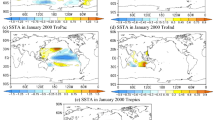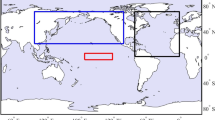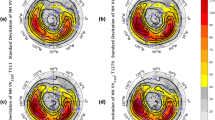Abstract
We examine the spatial patterns of variability of annual-mean temperature in the control runs of eight coupled atmosphere–ocean general circulation models (AOGCMs) and of observations. We characterize the patterns of variability using empirical orthogonal functions (EOFs) and using a new technique based on what we call quasi-EOFs. The quasi-EOFs are computed based on the spatial pattern of the correlation between the temperature variation at a given grid point and the temperature defined over a pre-determined reference region, with a different region used for each quasi-EOF. For the first four quasi-EOFs, the reference regions are: the entire globe, the Niño3 region, Western Europe, and Siberia. Since the latter three regions are the centers of strong anomalies associated with the El Niño, North Atlantic, and Siberian oscillations, respectively, the spatial pattern of the covariance with temperature in these regions gives the structure of the model or observed El Niño, North Atlantic, and Siberian components of variability. When EOF analysis is applied to the model control runs, the patterns produced generally have no similarity to the EOF patterns produced from observational data. This is due in some cases to large NAO-like variability appearing as part of EOF1 along with ENSO-like variability, rather than as separate EOF modes. This is a disadvantage of EOF analysis. The fraction of the model time-space variation explained by these unrealistic modes of variability is generally greater than the fraction explained by the principal observed modes of variability. When qEOF analysis is applied to the model data, all three natural modes of variability are seen to a much greater extent. However, the fraction of global time-space variability that is accounted for by the model ENSO variability is, in our analysis, less than observed for all models except the HadCM2 model, but within 20% for another three models. The space-time variation accounted for by the other modes is comparable to or somewhat larger than that observed in all models. As another teleconnection indicator, we examined both Southern Oscillation Index (SOI) and its relation to tropical Pacific Ocean temperature variations (the qEOF2 amplitude), and the North Atlantic Oscillation Index (NAOI) and its relation to North Atlantic region temperatures (the qEOF3 amplitude). All models exhibit a relationship between these indices, and the qEOF amplitudes are comparable to those observed. Furthermore, the models show realistic spatial patterns in the correlation between local temperature variations and these indices.




















Similar content being viewed by others
References
Achuta Rao K, Sperber KR (2002) Simulation of the El Niño Southern Oscillation: results from the Coupled Model Intercomparison Project. Clim Dyn 19: 191–209
Arblaster JM, Meehl GA, Moore AM (2002) Interdecadal modulation of Australian rainfall. Clim Dyn 18: 519–531
Bacher A, Oberhuber JM, Roeckner E (1998) ENSO dynamics and seasonal cycle in the tropical Pacific as simulated by the ECHAM4/OPYC3 coupled general circulation model. Clim Dyn 14: 431–450
Barnett TP (1999) Comparison of near-surface air temperature variability in 11 coupled global climate models. J Clim 12: 511–518
Bell J, Duffy P, Covey C, Sloan L (2000) Comparison of temperature variability in observations and sixteen climate model simulations. Geophys Res Lett 27: 261–264
Cai W, Watterson IG (2002) Modes of interannual variability of the southern hemisphere circulation simulated by the CSIRO climate model. J Clim 15: 1159–1174
Collins M (2000) The El Niño-southern oscillation in the second Hadley Centre coupled model and its response to greenhouse warming. J Clim 13: 1299–1312
Collins M, Tett SFB, Cooper C (2001) The internal climate variability of HadCM3, a version of the Hadley Centre coupled model without flux adjustments. Clim Dyn 17: 61–81
Corti S, Molteni F, Palmer TN (1999) Signature of recent climate change in frequencies of natural atmospheric circulation regimes. Nature 398: 799–802
Dai A, Wigley TML (2000) Global patterns of ENSO-induced precipitation. Geophys Res Lett 27: 1283–1286
Delworth TL, Mann ME (2000) Observed and simulated multidecadal variability in the Northern Hemisphere. Clim Dyn 16: 661–676
Delworth TL, Mehta VM (1998) Simulated interannual to decadal variability in the tropical and sub-tropical North Atlantic. Geophys Res Lett 25: 2825–2828
Delworth TL, Stouffer RJ, Dixon KW, Spelman MJ, Knutson TR, Broccoli AJ, Kushner PJ, Wetherald RT (2002) Review of simulations of climate variability and change with the GFDL R30 coupled climate model. Clim Dyn 19: 555–574
Doherty R, Hulme M (2002) The relationship between the SOI and extended tropical precipitation in simulations of future climate change. Geophys Res Lett 29 (10): 113, DOI 10.1029/2001GL014601
Emori S, Nozawa T, Abe-Ouchi A, Numaguti A, Kimoto M, Nakajima T (1999) Coupled ocean–atmosphere model experiments of future climate change with an explicit representation of sulfate aerosol scattering. J Meteorol Soc Japan 77: 1299–1307
Flato GM, Boer GJ, Lee WG, McFarlane NA, Ramsden D, Reader MC, Weaver AJ (2000) The Canadian Centre for Climate Modelling and Analysis Global Coupled Model and its climate. Clim Dyn 16: 451–467
Fyfe JC, Boer GJ, Flato GM (1999) The Arctic and Antarctic oscillations and their projected changes under global warming. Geophys Res Lett 26: 1601–1604
Gordon C, Cooper C, Senior CA, Banks H, Gregory JM, John, TC, Mitchell JFB, Wood RA (1999) The simulation of SST, sea ice extents and ocean heat transports in a version of the Hadley Centre coupled model without flux adjustments. Clim Dyn 16: 147–168
Gordon HB, O’Farrell SP (1997) Transient climate change in the CSIRO coupled model with dynamic sea ice. Mon Weather Rev 125: 875–907
Handorf D, Petoukhov VK, Dethloff K, Eliseev AV, Weisheimer A, Mokhov II (1999) Decadal climate variability in a coupled atmosphere–ocean climate model of moderate complexity. J Geophys Res 104: 27,253–27,275
Harvey LDD (2003) Characterizing and comparing control-run variability of eight coupled AOGCMs and of observations. Part 2: precipitation. DOI 10.1007/s00382-003-0358-9
Hasselmann K (1999) Linear and nonlinear signatures. Nature 398: 755–756
Hunt BG, Elliott TI (2003) Secular variability of ENSO events in a 1000-year climatic simulation. Clim Dyn 20: 689–703
Johns TC, Carnell RE, Crossley JF, Gregory JM, Mitchell JFB, Senior CA, Tett SFB, Wood RA (1997) The second Hadley Centre coupled ocean–atmosphere GCM: model description, spinup and validation. Clim Dyn 13: 103–134
Jones PD, Kelly PM (1983) The spatial and temporal characteristics of Northern Hemisphere surface air temperature variations. J Climatol 3: 243–252
Jones PD, Osborn TJ, Briffa KR (1997) Estimating sampling errors in large-scale temperature averages. J Clim 10: 2548–2568
Jones PD, New M, Parker DE, Martin S, Rigor IG (1999) Surface temperature and its changes over the last 150 years. Rev Geophys 37: 173–199
Jones PD, Osborn TJ, Briffa KR, Folland CK, Horton EB, Alexander LV, Parker DE, Rayner NA (2001) Adjusting for sampling density in grid box land and ocean surface temperature time series. J Geophys Res 106: 3371–3380
Kang IS (1996) Association of interannual and interdecadal variations of global mean temperature with tropical Pacific SST appearing in a model and observations. J Clim 9: 455–464
Kelly PM, Jones PD, Pengqun J (1999) Spatial patterns of variability in the global surface are temperature data set. J Geophys Res 104: 24,237–23,256
Knutson TR, Manabe S (1998) Model assessment of decadal variability and trends in the tropical Pacific Ocean. J Clim 11: 2273–2296
Knutson TR, Manabe S, Gu D (1997) Simulated ENSO in a global coupled ocean–atmosphere model: multidecadal amplitude modulation and CO2 sensitivity. J Clim 10: 138–161
Latif M et al (2001) ENSIP: the El Niño simulation intercomparison project. Clim Dyn 18: 255–276
Li T, Hogan TF (1999) The role of the annual-mean climate on seasonal and interannual variability of the tropical Pacific in a coupled GCM. J Clim 12: 780–792
Liu J, Yuan X, Rind D, Martinson DG (2002) Mechanism study of the ENSO and southern high latitude climate teleconnections. Geophys Res Let 29: 10.1029/2002GL015143
Meehl GA, Branstator GW, Washington WM (1993) Tropical Pacific interannual variability and CO2 climate change. J Clim 6: 42–63
Meehl GA, Arblaster JM, Strand WG (2000) Sea-ice effects on climate model sensitivity and low frequency variability. Clim Dyn 16: 257–271
Meehl GA, Gent P, Arblaster JM, Otto-Bliesner B, Brady E, Craig A (2001) Factors that affect amplitude of El Niño in global coupled climate models. Clim Dyn 17: 515–526
Mitchell JFB, Johns TC (1997) On modification of global warming by sulfate aerosols. J Clim 10: 245–267
Mitchell JFB et al (2001) Detection of climate change and attribution of causes. In: Houghton JT et al. (eds) Cambridge. Climate change 2001: the scientific basis. Cambridge University Press, UK, pp 695–738
Monahan AH, Fyfe JC, Flato GM (2000) A regime view of Northern Hemisphere atmospheric variability and change under global warming. Geophys Res Lett 27: 1139–1142
Osborn TJ, Briffa KR, Tett SFB, Jones PD (1999) Evaluation of the North Atlantic oscillation as simulated by a coupled climate model. Clim Dyn 15: 685–702
Preisendorfer RW (1988) Principal component analysis in meteorology and oceanography. Elsevier, Amsterdam, pp 425
Raible CC, Luksch U, Fraedrich K, Voss R (2001) North Atlantic decadal regimes in a coupled GCM simulation. Clim Dyn 18: 321–330
Schlesinger ME, Ramankutty M (1992) An oscillation in the global climate system of period 65–70 years. Nature 367: 723–726
Schneider EK, Zhengxin Z, Giese BS, Huang B, Kirtman BP, Shukla J, Carton JA (1997) Annual cycle and ENSO in a coupled ocean–atmosphere general circulation model. Mon Weather Rev 125: 680–702
Slonosky VC, Yiou P (2001) The North Atlantic Oscillation and its relationship with near surface temperature. Geophys Res Lett 28: 807–810
Stephenson DB, Pavan V (2003) The North Atlantic Oscillation in coupled climate models: a CMIP1 evaluation. Clim Dyn 20: 381–399
Stouffer RJ, Hegerl G, Tett S (2000) A comparison of surface air temperature variability in three 1000-yr coupled ocean–atmosphere model integrations. J Clim 13: 513–537
Tett SFB, Johns TC, Mitchell JFB (1997) Global and regional variability in a coupled AOCGM. Clim Dyn 13: 303–323
Timmermann A, Latif M, Grötzner A (1998) Northern Hemisphere interdecadal variability: a coupled air-sea mode. J Clim 11: 1906–1931
Timmermann A, Latif M, Grötzner A, Voss R (1999) Modes of climate variability as simulated by a coupled general circulation model. Part I: ENSO-like climate variability and its low-frequency modulation. Clim Dyn 15: 605–618
Trenberth KE, Hoar TJ (1997) El Niño and climate change. Geophys Res Lett 24: 3057–3060
van den Dool HM, Saha S, JohanssonÅ (2000) Empirical orthogonal teleconnections. J Clim 13: 1421–1435
Von Storch JS, Kharin VV, Cubasch U, Hegerl GC, Schriever D, von Storch H, Zorita E (1997) A description of a 1260-year control integration with the coupled ECHAM1/LSG general circulation model. J Clim 10: 1525–43
Walland DJ, Power SB, Hirst AC (2000) Decadal climate variability simulated in a coupled general circulation model. Clim Dyn 16: 201–211
Washington WM, Weatherly JW, Meehl GA, Semtner AJ, Bettge TW, Craig AP, Strand WG, Arblaster JM, Wayland VB, James R, Zhang Y (2000) Parallel climate model (PCM) control and transient simulations. Clim Dyn 16: 755–774
Wigley TML (2000) ENSO, volcanoes and record-breaking temperatures. Geophys Res Lett 27: 4101–4104
Wigley TML, Jaumann PJ, Santer BD, Taylor KE (1998) Relative detectability of greenhouse gas and aerosol climate change signals. Clim Dyn 14: 781–790
Yuan X, Martinson DG (2001) The Antarctic dipole and its predictability. Geophys Res Lett 28: 3609–3612
Yukimoto S, Endoh M, Kitamura Y, Kitoh A, Motoi T, Noda A, Tokioka T (1996) Interannual and interdecadal variabilities in the Pacific in an MRI coupled GCM. Clim Dyn 12: 667–683
Yukimoto S, Endoh M, Kitamura Y, Kitoh A, Motoi T, Noda A (2000) ENSO-like interdecadal variability in the Pacific Ocean as simulated in a coupled general circulation model. J Geophys Res 105: 13,945–13,963
Zhang Y, Wallace JM, Battisti DS (1997) ENSO-like interdecadal variability: 1900–93. J Clim 10: 1004–1020
Zorita E, González-Rouco F (2000) Disagreement between predictions of the future behavior of the Arctic Oscillation as simulated in two different climate models: implications for global warming. Geophy Res Lett 27: 1755–1758
Acknowledgements.
This work was support by NSERC research grant OPG0001413 (Harvey), by the ACACIA (a joint NCAR-EPRI program), and by the NOAA Office of Global Programs (Climate Change Data and Detection) under grant NA87GP0105 (Wigley). The constructive comments of two reviewers on an earlier version of this study is appreciated.
Author information
Authors and Affiliations
Corresponding author
Rights and permissions
About this article
Cite this article
Harvey, L.D.D., Wigley, T.M.L. Characterizing and comparing control-run variability of eight coupled AOGCMs and of observations. Part 1: temperature. Climate Dynamics 21, 619–646 (2003). https://doi.org/10.1007/s00382-003-0357-x
Received:
Accepted:
Published:
Issue Date:
DOI: https://doi.org/10.1007/s00382-003-0357-x




